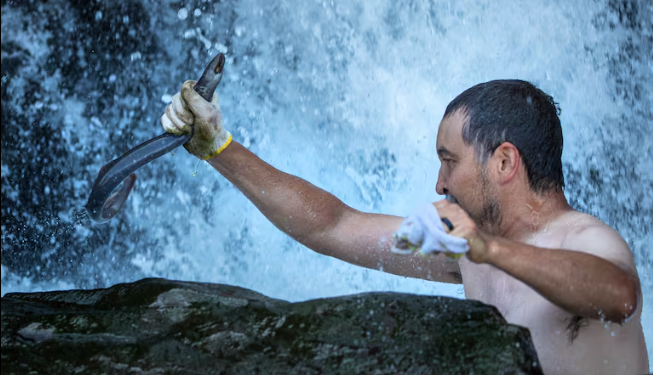The eel-like fish join the likes of salmon and sturgeon as a first food, a staple for local tribes long before European contact. But their numbers are dwindling.
||| FROM OREGON PUBLIC BROADCASTING |||
The eel-like fish join the likes of salmon and sturgeon as a first food, a staple for local tribes long before European contact. But their numbers are dwindling.
At the base of Willamette Falls, a wall of 40-foot rocks towers over the reservoir. The falls are deafening. A mist hangs over the air.
Several people are submerged near the falls. They’re here every summer to catch lamprey the same way Indigenous people of the Pacific Northwest have caught them for millennia.
Ralph Lampman, a Lamprey Project Lead for Yakama Nation Fisheries, is one of them. He takes a deep breath and disappears under the water. The falls crash directly above him, hitting against sharp rocks to froth and spray the air.
Suddenly, he reemerges. “I got one!” he yells. Above his head, a long, scaleless, eel-like fish squirms in his fist, its round mouth waving in the air.
Lampman isn’t Indigenous, but a Yakama Nation tribal member taught him to catch lamprey eight years ago.
These harvesters are here to catch lamprey for an annual Willamette Falls lamprey celebration. Community members were able to gather in Clackamette Park to eat grilled lamprey and acknowledge the decreasing numbers of lamprey in the Willamette — a result of dams blocking their path upstream.
The tradition of catching lamprey by hand under the falls has fed generations of Indigenous communities over thousands of years. Lamprey join the likes of salmon and sturgeon as a first food, one of the foods that local tribes ate long before European contact.
But the environment where lamprey long returned to reproduce is changing. Their numbers are falling dramatically. If conservation efforts are not implemented, there won’t be any lamprey left for future generations.
“They’ve lasted through ice ages, through everything you can imagine, for millions of years,” he said. “They’re the ones that are the most important. We can’t lose sight of that.”
Lamprey are long, scaleless and slimy. They have round, toothed, perpetually open mouths with suckers that help them attach to rocks and fish.
After hatching, the lamprey develop their four eyes and sharp teeth in freshwater before migrating to the ocean. Then they spend one to three years feeding on fish as parasites.
Much like salmon and sturgeon, lamprey have to migrate back to freshwater to spawn. Before dams, they were able to suck on rocks and squirm their way upstream. But now, dams are creating an enormous obstacle.
**If you are reading theOrcasonian for free, thank your fellow islanders. If you would like to support theOrcasonian CLICK HERE to set your modestly-priced, voluntary subscription. Otherwise, no worries; we’re happy to share with you.**








